WRTA: 23 (Union Station Hub – East Mountain Street via Lincoln Street)
There’s a 23 leaving from the Hub in 9 minutes? Alright, let’s do the 23.
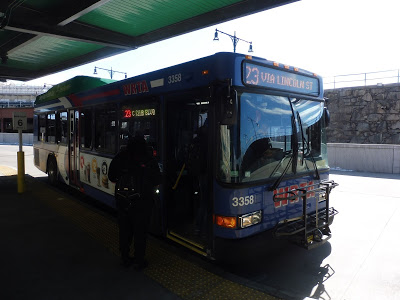 |
| Excellent. |
We headed up Foster Street, then we turned onto Major Taylor Boulevard. This was a wide road that passed a lot of office buildings with big parking lots, as well as the DCU convention center. We eventually merged onto Lincoln Street, which went under I-290. The tall buildings ended immediately; now we were passing dense houses and some businesses.
 |
| All of the side streets were steep hills! |
There was some retail along the street as we reached Brittan Square. After a hospital, Lincoln Street curved to a northeast trajectory, and it was residential until we once again went under I-290. There was a huge office building on the other side, then Lincoln Street was lined with suburban businesses. One of them was the Lincoln Mall, and luckily, we didn’t have to deviate!
 |
| Not the Lincoln Mall, but apparently Kohl’s! |
We turned onto Country Club Boulevard, a wide street with an equally wide median. It took us through the Lincoln Village Apartments, a mixture of smaller apartments and big buildings. The road ended at the Worcester Art Magnet School (where the route terminates on its snow route), where we turned onto Saint Nicholas Ave. It became lined with houses as it went up a hill.
 |
| What a view these folks must have! |
We turned onto Clark Street, which went down a steep hill – my ears popped! There were houses, apartment developments, and even a few office buildings along here, and it continued as we turned onto Mountain Street East. Coming up along a golf course, we reached our terminus, the aptly-named Fairways Apartments.
 |
| Heading back to Worcester. |
WRTA Route: 23 (Union Station Hub – East Mountain Street via Lincoln Street)
Ridership: The 23 gets great ridership for WRTA, receiving 726 passengers per weekday, 257 per Saturday, and 137 per Sunday. My Saturday trip was interesting in that more than half of the 8 passengers (we were going outbound in the morning, so low ridership was expected) got on at local points past the hub. I love seeing routes that get local ridership like that!
Pros: The 23 is very direct, and it serves a dense corridor frequently; service is every half hour weekdays and every hour on weekends. On weekdays, it’s even better, since the route is coordinated to run every 15 minutes with the 26 on Lincoln Street – they run together all the way until the Lincoln Mall.
Cons: WRTA…you’re running 15 minute service on a corridor. ADVERTISE IT! Don’t you think more people are likely to ride the bus if they know that the 23 and the 26 combine to create service that frequent on weekdays? There’s no indication of this on either of their schedules! Other problems include the wacky Saturday service that’s technically every hour, but it shifts around by five minutes all throughout the day (4:30, 5:25, 6:30, 7:20, etc.), as well as the route’s strange service patterns. It can terminate in a few different places throughout the day: most of the time, it’s at the Fairways, but three evening trips terminate at an office building on Century Drive (which is so close to the route that the workers there could walk to the closest stop in a few minutes), the second-to-last outbound trip on weekdays ends at the Great Brook Valley Community Center, and the last weekday and two last Sunday outbound trips end at Lincoln Plaza. This is displayed horribly on the route’s map, too – service to Century Drive is displayed as a dotted line, which makes sense, but the Great Brook Valley routing is displayed exactly the same as the rest of the route. It looks like a deviation, but it’s actually just one outbound trip on weeknights!
Nearby and Noteworthy: The route ends in a wasteland of forest and housing developments, so…no, not really.
Final Verdict: 6/10
The 23 annoys me to no end, but it’s overall a good route. It runs frequently, it serves a major corridor, and it gets a lot of people. But boy, talk about cons! I don’t want to repeat everything I mentioned above, but the most important change that can be made to the 23 is better advertising for the coordination with the 26. I’ll discuss this more in the next review (which is of the 26), but it’s absolutely insane that the WRTA doesn’t push this, or at least give some indication of its existence!
Latest MBTA News: Service Updates
Wow, it didn’t occur to me until just now to advertise this on the blog: come see me speak at TransportationCamp! I’m doing a presentation about the RTAs (of course), and there’ll be a ton of other awesome sessions there. There are still tickets available, so get them while you can!
Also, the SL3 opens tomorrow, and somehow I’m gonna pack a review of that into the same day as the presentation. Boy oh boy, tomorrow is gonna be quite a day!
Logan Airport Shuttle: 99 (Back Bay Logan Express)
Yeah, this is technically a Logan Express, but they refer to it as the 99 on certain countdown clocks, so we’re calling it a Logan Airport Shuttle. No, I’m not going to do the other Logan Express routes. Okay, let’s go!
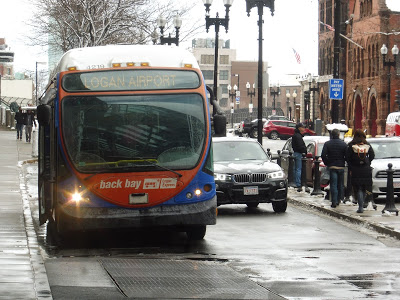 |
| Boarding at Hynes. |
The route starts at a drop-off area at the Hynes Convention Center, so that’s where Nathan and I went to pick it up. I did a service change of this route back when it was free for CharlieCard users, but that has since changed. Now, the cost is $3.00 for people with CharlieCards and $7.50 for people without them…credit/debit card only. Yes, the driver literally takes out a handheld reader that he uses to swipe passengers’ cards (and you get a weird little paper ticket). They already use specific buses to run this route – how hard would it be to put a farebox that also accepts cash on them???
 |
| Nice! |
From Hynes, we headed down Boylston Street, passing businesses, apartments, and the Prudential Center. We came into Copley Square, making a stop along the square next to the Boston Public Library, the John Hancock Tower, Trinity Church, and lots and lots of businesses. From there, we looped around onto Saint James Ave via Clarendon Street and made another stop on the south side of the square.
 |
| Interesting reviewing a route around here again! |
It was straight onto I-90 West from there, which was running in its tunnel through the Back Bay. We surfaced at the Hynes Convention Center, and there were tons of buildings flanking the highway. Passing Fenway Park and Yawkey Station, we went through the BU campus and went onto a bridge alongside Storrow Drive and the Charles River.
 |
| Time to turn around… |
Now, of course, Logan Airport is east of Copley Square, but we were going west. It was time for that classic part of the route where it turns around and comes straight back the other way! Unfortunately, this is the fastest way to go, even though it feels super inefficient. So, we went all the way back to the Back Bay tunnel and came out on the other side.
 |
| Hmm…not the straightest photo ever taken… |
We were only out for a little bit before going underground again through the Fort Point Channel. The highway went under the Seaport District and then straight through Boston Harbor to get to the airport. Coming out at the airport, we looped around onto the departures level road and pulled into Terminal A to drop our one passenger off. Unfortunately, we had to serve Terminal B because of the road structure of the airport, but the driver knew Nathan and I were going to E – he had asked us when we got on. This meant we could skip C, and it was straight on to E.
 |
| A bus going back into the city. |
Logan Airport Shuttle Route: 99 (Back Bay Logan Express)
Ridership: Well, just one other person going to the airport. However, I’ve seen this bus plenty busy at other times – it never gets more than about a full-seated load, but for an airport shuttle, that’s pretty good.
Pros: This is the fastest public transportation connection from the airport to the Back Bay area, and since it’s nonstop, it’s probably just as fast as a cab. It’s much cheaper, though – $7.50 for non-CharlieCard users sounds expensive, but when you think about what a cab would cost, it’s great! I also like how the outbound route only serves the terminals where the passengers want to go, and the route runs at a clean 20-minute headway.
Cons: Credit/debit card only? That’s such a pain, come on! It wouldn’t be hard to put fareboxes specifically into the buses with the Back Bay Logan Express paint scheme to allow travelers to pay with cash as well. Also, it’s strange that the route the bus takes is up to interpretation: it mostly travels the roundabout I-90 way, but sometimes it uses local streets to get to I-93 in the South End, then it goes back up to the Ted Williams Tunnel. It’s not a huge deal, but it would be nice if the alternative route got an announcement like the normal one does (it explains how the bus will go down I-90 and turn around).
Nearby and Noteworthy: Copley Square is awesome! Did you know that? I’m sure you didn’t – Copley Square is really a little-known Boston secret that no one knows about.
Final Verdict: 7/10
If you’re going from Logan to the Back Bay, this is the way to go. It’s fast, it’s nonstop, it’s frequent, and it’s pretty cheap. Just make sure you have a credit or debit card, because otherwise too bad, you can’t get on. Seriously, Massport…FAREBOXES!
UPDATE (June 2019): This has been the case for a little while now, but it’s worth noting that the route is now free from the Airport to Boston. The fare to the airport has been dropped to $3, but it’s still credit/debit only. I think a 7 still seems reasonable here.
Latest MBTA News: Service Updates
Wyoming Hill
So…a four-minute bus ride from Wyoming Hill to Oak Grove is the difference between spending $6.25 to get into Boston and spending $2.25 to get into Boston. Uhhh…well, if you really want to take Option 1, you’ll be using Wyoming Hill.
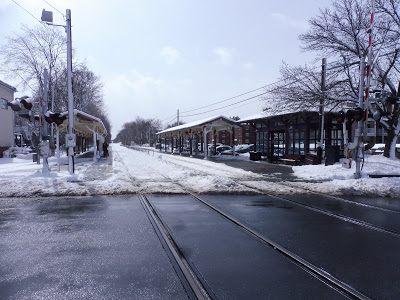 |
| Yup, it’s another basic station. |
Both platforms at Wyoming Hill have pleasant shelters with a few benches underneath. The inbound side has an additional shelter with walls, so it feels a little more cozy – too bad people seem to throw their trash in there a lot. The inbound platform also has bike racks, including some sheltered ones with a special spot for 3-wheeled bicycles (by the way, the bike ride to Oak Grove is only six minutes!). As far as car parking goes, there are 30 spaces here.
 |
| oh look its oak grove………….. |
Station: Wyoming Hill
Ridership: I wonder what it feels like to be the least-used station on the Haverhill Line. Poor Wyoming Hill gets just 123 inbound passengers per weekday. Ouch…
Pros: The station itself is rather nice. Both platforms are sheltered, with a bonus shelter on the inbound side, and there’s lots of bike parking. The lot for cars is small, but this is a super local station that doesn’t need a big lot. Also, parking is free after 12 PM and on weekends, which is awesome!
Cons: It’s so close to Oak Grove, where hopping on the Orange Line is so much cheaper. Yes, the subway is obviously slower, but not by more than about 10 to 15 minutes. Plus, the train takes you to far more destinations within Boston, and it’s frequent, unlike the Haverhill Line! The 131, 132, 136, and 137 all go from here to Oak Grove and Malden Center, creating (relatively) frequent service on weekdays. There’s just very little reason to use this station unless you really don’t like crowds on the subway.
Nearby and Noteworthy: The station is technically in “Wyoming Square,” which means there are plenty of businesses nearby. Downtown Melrose on Main Street is a quick walk away, too.
Final Verdict: 4/10
As a station, Wyoming Hill is definitely better than Melrose Cedar Park. The problem is that there’s just very little point in this station existing! The fares are way too high and the stop is way too close to rapid transit to justify using it with its high Commuter Rail fares. At least it’s usually a flag stop…
Latest MBTA News: Service Updates
Melrose Cedar Park
Okay, this station definitely used to be called “Melrose/Cedar Park,” with a slash. I guess we’re not doing that anymore? Alright. Fine. Let’s look at Melrose Cedar Park.
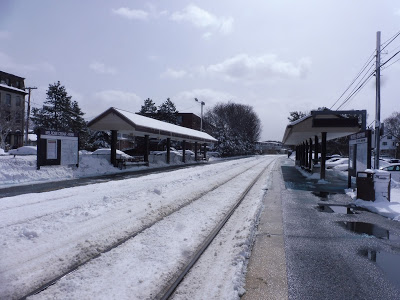 |
| One sign says “Melrose-Cedar Park” and the other one says “Melrose Cedar-Park”! Nothing’s consistent! |
 |
| A Boston-bound train. |
North Wilmington
Oh…well, that’s what I get for complaining about Ballardvale. North Wilmington proves that things can always get worse.
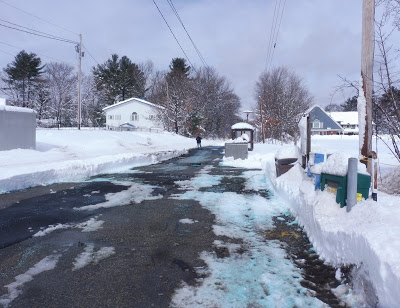 |
| See that raised bit over there? That’s the platform. |
So yeah…what have we here? There’s a section with a Haverhill Line schedule, a wastebasket, and some newspaper boxes, but it’s not actually part of the platform. The platform is just a tiny strip of asphalt less than a car length long, and all it has on it are an awful bike rack and a bus shelter. And…I think that’s it. Wait, this station has 20 free parking spaces? Where???
 |
| Pretty! |
Station: North Wilmington
Ridership: This stop gets 310 inbound people per day??? That’s not that many, but it’s a lot for the Haverhill Line! Also, can you imagine rush hour crowds at the tiny platform? Geez!
Pros: Sigh…free parking is nice…
Cons: There’s not much explanation necessary here. Tiny platform, bus shelter, no amenities. Capiche?
Nearby and Noteworthy: There are some suburban businesses around here, mostly in the form of pizza joints and cafés. There’s also an RMV, so I guess that’s nice…?
Final Verdict: 1/10
Blechhhhhh. Echhhhhhh. Blehhhhhhhh. 1/10.
Latest MBTA News: Service Updates
Ballardvale
This is one of those Commuter Rail stations that just begs the question: how? How can a station be this badly designed? Ballardvale is truly an enigma!
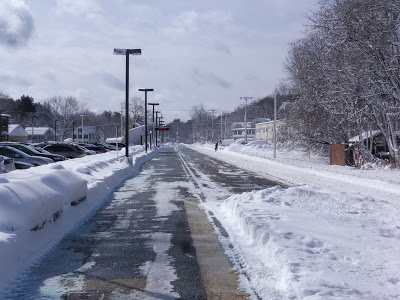 |
| Huh… |
Okay, Ballardvale clearly used to be two tracks, because the platform is abnormally wide. It’s just this weird long low-level thing with a random curb in the middle of it. There’s a shelter closer to the station’s entrance, but it’s wooden and dingy. There are also a few wastebaskets, ads, and a broken payphone. As far as car parking goes, there are 115 spaces in a lot next to the station.
 |
| Yup…that’s our mini-high. |
The mini-high platform is so far down that trains don’t even bother to stop there! I can’t imagine the chaos that would ensue of someone actually needed to use it! The platform itself is really wide, since they had to build an extension over the nonexistent second track, but barely any of it is sheltered, and there aren’t benches up there. Also, the extension portion feels like it’s going to collapse at any moment – that’s always great.
 |
| At least the snow is scenic… |
Station: Ballardvale
Ridership: Ballardvale is one of the lesser-used stations on the Haverhill Line, which in itself is a line with low ridership. Yup, this place gets just 259 inbound riders per weekday. Not great.
Pros: Hmm…well, it exists. It has parking. It’s technically accessible…I guess.
Cons: Look at it! We’re dealing with this really wide platform that has a strange curb that runs along it (and the outer half of it eventually gets replaced by abyss as you get closer to the mini-high), a useless mini-high platform that trains don’t even stop at, and a really dingy wooden shelter. WHAT’S NOT TO HATE?!?!?!?!?
Nearby and Noteworthy: There are some TOD apartments next to the station, but as far as businesses go, there isn’t much. You’ve got a pizza place, a convenience store, and a café…huh, well, those are better offerings than your typical Old Colony station, though!
Final Verdict: 2/10
Ballardvale does almost nothing right. In fact, does it do anything right? It seems like every decision made for this station was terrible! I guess the only thing keeping it from a 1 is that it’s sortaaaaaa functional, a little, maybe? Ech.
Latest MBTA News: Service Updates
Pawtucket Transit Center
The Pawtucket Transit Center is a strange little place. It’s not as raucous and busy as Kennedy Plaza, but it’s not like it’s an oasis from crazy occurrences. Case in point…
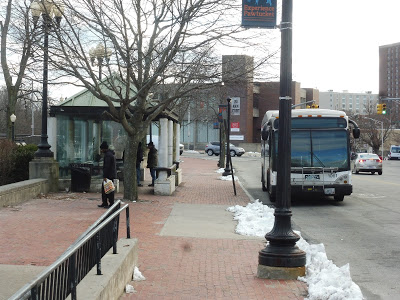 |
| There was a fight going on at that shelter, so Sam and I hung back to get this picture. |
The Pawtucket Transit Center is interesting in that it has two bus stops, but RIPTA doesn’t tell you which routes stop at which. There’s technically a “berth map” on the station page, but it only leads to a low-quality close-up of the Pawtucket section of the RIPTA system map. Well, let’s settle this now: on the Slater Mill side, which has a big (and kinda sketchy) shelter, the 71, 72, and 73 board, as well as the 1, but only on South Attleboro trips. Not confusing at all!
 |
| This is where the magic happens! |
The other side feels a lot more like a transit center, with RIPTA-branded awnings sticking out from the building. There are benches underneath, as well as a system map and a list of the routes that stop at this berth (the 1 (southbound), 71, 75, 76, 78, 80, and R-Line). They really need to make it more clear where all the routes stop – an online map would be incredibly helpful, and it would be simple to make.
 |
| Inside the building. |
There’s an inside here, and it’s basic. All it really has are some benches, some random posters all around the room, some cool floor-to-ceiling historical photos, and paper schedules along a wall. Also, there’s a weird smell. Yup.
 |
| Well, this is a change! |
I’m not sure if it’s part of the “review” or not, but the transit center connects directly to the Pawtucket Visitor’s Center. It’s this huge majestic room with a ton of historical information and reasons as to why Pawtucket is a really noteworthy city in history…but the center always seems to be empty. I think people only go in here because this is where the bathrooms are, and they’re in…uh…passable shape…?
 |
| Ehhh…at least it didn’t smell. |
RIPTA Station: Pawtucket Transit Center
Ridership: This place has nowhere near the ridership of Kennedy Plaza, but it always has a good amount of people milling around. For some, it’s questionable if they’re waiting to ride the bus or not, but oh well…still people.
Pros: For all its flaws, it’s nice that there is an indoor area. If it rains, I’m sure many people go in there, although people seem to choose to wait outside when the weather’s nice. I like all the amenities it has, and there is outdoor seating and shelter for those who desire it.
Cons: That indoor area is only open from 10 AM to 4 PM, meaning it completely misses the rush hours! I mean, I don’t know how many people are commuting from Pawtucket to Providence (or somewhere else), but it seems strange to have those be the hours with a system as big as RIPTA. Also, the whole thing feels dingy all-around, from the Slater Mill shelter to the weird smell in the indoor room to the questionable bathrooms. Finally, the whole two-berth thing works, but there needs to be better signage for it. All they need is a simple map!
Nearby and Noteworthy: The Slater Mill Historic Site looks like a really cool place. It captures the history of Pawtucket in a historic mill!
Final Verdict: 4/10
Yeah, not a big fan of this one. I’m glad it exists, but it has a lot of problems. The opening hours for the building are sad, the place is dingy, and there needs to be a map explaining which route stops where. The Pawtucket Transit Center is functional, but it’s not a place I would want to wait at for very long.
Latest MBTA News: Service Updates
RIPTA: 72 (Weeden/Central Falls)
Want to get from Providence to Pawtucket? Well, don’t use the 72! This route is all for the neighborhoods in between.
 |
| Not actually our bus – this was earlier in the day. |
We left Kennedy Plaza on Exchange Street, which went over the Woonasquatucket River and led us to Providence Station. After doing a little jog to serve it, we crossed the Moshassuck River and headed up North Main Street. There was a lovely park on one side and historical houses on the other, then we merged onto Charles Street, weaving our way past apartments and office buildings.
 |
| Man, the East Side is awesome. |
We went under I-95 and it got industrial, including a huge post office. Once we crossed the Northeast Corridor, some suburban businesses came up along the road, all with huge parking lots. We turned onto Silver Spring Street, passing the granddaddy of all suburban businesses with huge parking lots, Walmart.
 |
| Bam! |
It was lined with houses for a bit, but we came pretty close to the Northeast Corridor, and with it came industry. It morphed into suburban businesses when we entered Pawtucket and the street became Smithfield Ave, then one side of the road became occupied by a huge, dense cemetery. Past there, it became houses again, aside from an elementary school and a fire station right next to each other.
 |
| A short side street. |
There were a few businesses where we turned onto Mineral Spring Ave, joining the 73. It was just for a mere two blocks, though, after which we were alone on Power Road. It was almost all dense houses, continuing as we turned onto Weeden Street (aside from some retail at the intersection with Smithfield Ave).
 |
| Houses, houses, houses. |
There was a brief stretch of industry, but it was residential again after we went over a level crossing with a train track. We eventually turned onto Lonsdale Ave, which headed into Central Falls – it had some businesses between the houses. Reaching a church, we turned onto West Hunt Street, then we joined the 75 on Dexter Street.
 |
| A slight hill. |
This was a main drag of Central Falls, so it was lined with tons of businesses. We eventually went over the Northeast Corridor into Pawtucket, and everything got denser all of a sudden. Turning onto Main Street, we ran through Pawtucket’s rather dreary downtown before turning onto Roosevelt Ave, finishing the trip at the Pawtucket Transit Center.
 |
| The bus turned off in Pawtucket, so here’s one back in Providence. |
RIPTA Route: 72 (Weeden/Central Falls)
Ridership: My trip got 25 people, so that’s pretty darn good! Based on what the route serves, I would imagine it gets good ridership most of the time.
Pros: The 72 isn’t a direct link between its termini, but the key is the places it serves in between. The route serves a ton of neighborhoods that aren’t served by other routes, and it comes at pretty reasonable frequencies: every 30 minutes on weekdays, and every 45 minutes on weekends. Also, the route has normal layover times! It’s scheduled to take a normal time to complete, and buses aren’t sitting there for hours on end waiting for their next trip. Good for the 72!
Cons: Service stops at around 7, which seems a little early for an urban route like this. There isn’t much else wrong with it, but it can feel unnecessarily twisty at points.
Nearby and Noteworthy: I wasn’t very intrigued by the businesses along the 72. After all, Central Falls and Pawtucket aren’t exactly tourist destinations…
Final Verdict: 7/10
The 72 mostly acts as a connector route between local neighborhoods to Providence and Pawtucket, and it does its job well. It comes on time, it doesn’t spend too much time at its terminus, and it serves what it needs to serve. A fairly standard route, but a good one.
Latest MBTA News: Service Updates
Here’s an awesome Facebook group all about funding the Massachusetts RTAs. In the wake of cut funding from the state government, they need all the support they can get, so join the group if you want to help.
GUEST POST: Service Change: Transit in Melbourne
My girlfriend Zofia recently came back from a trip to Australia, and she wanted to report on the transit there. Here we go!
Melbourne, Australia: where to start with it? We could talk about all the great places you can go and eat, but I’ve been told that’s not the point of this blog….so I guess I’ll have to talk about the transit system there. Oh well.
Let’s talk about the tram system. The cool thing about their trams is that they range from the really terrible tourist-looking trolleys to nice modern day ones. Okay, fine, the tourist-looking ones are meant for tourists, but they do get you places! People who live there use them! Here’s why: they have a zone system where if you travel anywhere within the “Free Tram Zone,” you don’t have to pay a fare at all. Once you’re outside that zone, though, you have to make sure that you pay your fares. I don’t remember what the fare is, but they have a student, adult, and senior one. I looked online and from what I’m getting, the amount you pay depends on the zones that you travel through.
When you want to pay, you have to make sure that you tap your Myki, which is like a CharlieCard for us. When you get onto the tram or bus, you don’t necessarily have to tap on and off. You just have to tap on, but most people tap on and off just to be sure. However, on a train, you must tap on and off – the only way you can get in is if you tap your card, and the only way for you to leave the station is to tap your card again. Make sure you don’t lose that card while you’re sitting on the train, otherwise you’ll be stuck forever and that station will have to become your home. Unless you’re good at climbing over fences – then you can escape! Good luck if you do that!
They have countdown clocks at most tram stations, I believe. Of course they have them at the train stations. As for buses, if you have a smartphone, which you probably do because let’s be honest, who doesn’t have one? Okay, sure, I know one person who doesn’t have one, but other than that everyone has them, so just use the device to track the bus. I actually have no idea if there is an app for that but I feel like there would be. Someday I’ll look into it…
RIPTA: 21 (Reservoir/Garden City)
Arghhhh, the 21 is a hard one to sit through. It has a ton of deviations, it takes over 40 minutes to ride, and…blech. Let’s just get it over with.
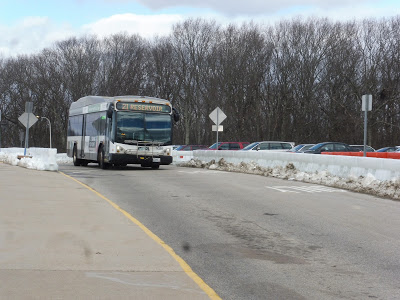 |
| Coming into CCRI. |
Unlike the other Warwick Mall to Providence routes (the 22 and the 30), the 21 begins past the mall, at CCRI. We left the brutalism capital of Rhode Island (seriously, it’s a really ugly building)…two minutes early? Woah, RIPTA buses never leave early! Usually they get so much time that if anything, a driver would want to leave a little late so they don’t have to wait places! What was going on?
 |
| A rather empty parking lot. |
We turned onto the wide East Ave, then we made a right onto Bald Hill Road. Clearly, we were going to use this to get up to the Warwick Mall…oh, or we could deviate into the Rhode Island Mall. Come on, the stop “inside” the mall is barely closer, and saves pedestrians a total of 1 minute of walking over if they were to just use the stop on the street!
 |
| The mall, as seen from East Ave. |
Okay, now time to go onto Bald Hill Road to the mall, right? Oh…okay, no, we’re going back down East Ave. This took us over a monstrous interchange between I-295 and I-95, then we turned onto the very wide Greenwich Ave. We passed a Stop & Shop and a Lowe’s (probably the reason the route is routed this way), then we went over I-95 again.
 |
| Going over the Pawtuxet River. |
There were some apartment buildings, a cemetery, and a church, then we crossed the Pawtuxet River, bringing us to the entrance of the ginormous Warwick Mall! But of course, the stop is wayyyyyy down on the south side of the mall, so we had to travel the length of the parking lot to get down there. This is the only route that goes through the mall (the other ones terminate here), so it made the deviation feel doubly painful because we had to do it twice. Also, geez, we were six minutes late! And we had left two minutes early! They give this thing no time!!!!!!
 |
| Coming into the mall. |
We left the mall on Lambert Lind Highway, which was lined with suburban businesses with parking lots. Once we entered Cranston, we turned onto Mayfield Ave, which was entirely residential – a big change from before. It turned into East Street, but then the area started to get industrial. We soon turned onto Howard Ave, which went through a campus full of various municipal buildings.
 |
| A side street within this strange land. |
We went by a hospital, which seems like it would warrant a deviation, but instead RIPTA decided to have the route deviate to…the DMV and Traffic Tribunal Center. Okay, I get it that a lot of people probably take the bus to these places, but do you really have to deviate for them? Just because someone doesn’t have a car doesn’t mean they can’t walk for three minutes!
 |
| Deviatin’. |
We made our way onto New London Ave, which went through a big cloverleaf interchange with Route 37. On the other side of that interchange, we…deviated again??? This time, it was to serve the Garden City Center, and it required that we go down Sockanosset Cross Road and turn onto Midway Road. Now, this deviation makes more sense when you look at it on a map: Garden City Center is a “lifestyle center” that was built in this really weird self-contained way that makes it super hard to get to from the main road…but it was still annoying to have to deviate to it.
 |
| One side had the mall, one side had apartments. Guess which one I was on. |
We turned onto Garden City Drive, then we made our way back onto the main road, which was now called Reservoir Ave. Garden City Center was luckily our last deviation, so it was now a straight shot past endless ugly businesses with dense houses on the side streets. I’m serious, it was like that until our next turn, which was an unexpected one, to say the least.
 |
| A typical side street. |
We turned onto Pontiac Ave, then headed for an on-ramp to, yes, an express section. Man, RIPTA loves its express routes, huh? Yes, we were now on Route 10, and we were sailing past a bunch of industrial buildings. We entered Providence, and it got more residential as we came close to Olneyville Square, where the highway became Route 6.
 |
| An apartment building. |
We came up alongside the Northeast Corridor as we headed around the north side of Federal Hill. Finally, we passed through a huge interchange with I-95, and the highway was done. We made our way around downtown Providence on Memorial Boulevard, then we turned onto Kennedy Plaza, and that was that!
 |
| Wow, lots of people going back! |
RIPTA Route: 21 (Reservoir/Garden City)
Ridership: The route seems to get good ridership: my Saturday trip got 20 people, and just look at all the passengers waiting to leave the city in the photo above! Interestingly, most people started boarding our bus north of the DMV, with very few coming from the malls or CCRI. Maybe that’s an anomaly.
Pros: The route serves a dense corridor in Cranston, and thanks to the express section, it can get to Providence quickly. The schedule seems to make sense: every half hour on weekdays, every 40 minutes on Saturdays, and every 50 minutes on Sundays.
Cons: Although then again, look at that crowd up there…I wonder if the route could stand to be a little more frequent on weekends. Other cons include the annoying amount of deviations, the long layover times at CCRI, and the fact that the route does not get nearly enough time! I mean, we stayed at a consistent three minutes late past the Warwick Mall, but keep in mind that we left two minutes early. The route’s schedule needs an adjustment, and it would be so easy just to take some time off that 25 minute layover.
Nearby and Noteworthy: Garden City Center seemed like a decent place, even though it’s designed awfully as far as the road network goes.
Final Verdict: 6/10
The 21’s saving grace is that it gets a lot of people. Clearly, there are many that rely on this route. But man, it has a lot of problems! The deviations are annoying, the buses lay over for a ridiculously long time at CCRI, and the route is always late! They’re all fairly simple fixes, but it’s enough to drop the score to a 6.
Latest MBTA News: Service Updates
RIPTA: 50 (Douglas Ave/Bryant University)
Can the 50 really be considered a Key Corridor Route if only a third of its length gets the frequent service? And the rest of it is basically in the middle of nowhere? Well, I have to review it either way, so let’s start at the brutalist outpost known as Bryant University way out in Smithfield, RI!
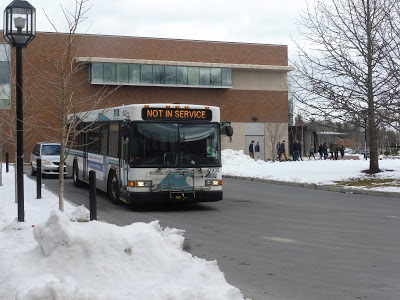 |
| Not in service? Pah! |
We left the university on the twisty and woodsy Jacob Drive – although in order to leave, we had to pass through a weird security gate. Upon our departure of the campus, we turned onto Douglas Pike, a wide and fast road through forests and fields. There were a few office parks around I-295, which we crossed over, but it was more or less the middle of nowhere again after that. We picked up two people at some random motel called Alpine, which was unexpected.
 |
| Is that a bull??? IS THERE HALF HOURLY SERVICE TO BULLS?!?!?!?!? |
We continued past more forest, although now there were a few houses and even some industrial buildings and businesses, such as “JIM ANDERSON’S GUN SHOP.” Fun stuff! Eventually, there was a really nice bit where we went on an isthmus through the Wenscott Reservoir, offering fantastic views on either side. On the other side of that reservoir, we were in North Providence, and it was much more urban now.
 |
| Wow! |
There were a lot of apartment developments just over the reservoir, then there was a brief section of fairly dense houses. At the intersection with Mineral Spring Ave, there were a few huge suburban businesses (the biggest of which was a Lowe’s), and then it was houses again. We suddenly turned off Douglas Ave in order to serve a Shaw’s – this is where every other trip on weekdays begins.
 |
| An earlier trip coming out of Shaw’s. |
We went down Admiral Street for a bit before turning onto the residential Burns Street. This led us back to Douglas Ave, which was mostly residential. There was an elementary school and a convenience store at the intersection with Veazie Street, and there were a few industrial buildings between the houses beyond there. We went by some more retail at the intersection with Admiral Street, which is served by the 55.
 |
| Speak of the devil, there it is! Although this is when we were turning onto Burns Street. |
It continued to be mostly residential, but we did also go by a few businesses and a nursing home. We passed a cemetery, and there was another burst of retail around Chalkstone Ave. After one more round of houses, we merged onto Orms Street and went over I-95, then we made a right onto State Street.
 |
| This is earlier in the route, but I just love this random lemonade store! |
It became Gaspee Street and we came alongside the Northeast Corridor while the majestic Rhode Island State House was on the other side of the road. We went by Providence Station, then we turned onto Francis Street, going alongside the Providence Place Mall. Once in downtown Providence, it was a straight shot down to Kennedy Plaza!
 |
| The original bus in Providence. |
RIPTA Route: 50 (Douglas Ave/Bryant University)
Ridership: Our trip got 18 people in total – there were 8 on the “outer section” (north of Shaw’s) and 10 on the “inner section.”
Pros: Douglas Ave is an important and dense corridor through Providence, plus this route connects Bryant University to the city. It also has reverse-peak trips that serve Fidelity Investments, an office park near Bryant, which is great. The route runs every 20 minutes on weekdays, with every other bus terminating at Shaw’s, then it becomes every 30 minutes on Saturdays and every 45 on Sundays. The service runs until 1 AM on Fridays where school is in session, which is an added bonus – normally it ends around 11, although that’s fine too.
Cons: One little one and one big one: for the little one, why is “Smith and Gaspee” a timepoint instead of Providence Station? They’re practically right next to each other, but the station seems like a way better timepoint than this random intersection! For the big one, does every bus have to go to Bryant University on Saturdays? It seems like buses spend a while trundling through the woods for not too many passengers.
Nearby and Noteworthy: Even within Providence, this is a mostly residential route. The best I can give ya is Shaw’s…
Final Verdict: 7/10
For a Key Corridor route, the 50 is a little long and unwieldy, but it does its job well overall. The long woodsy section beyond Shaw’s seems to be mostly to get to Bryant University and Fidelity Investments, so it feels far less used than the inner section – maybe there would be a benefit in only running every other bus up there on Saturdays, although I could be completely wrong.
Latest MBTA News: Service Updates
RIPTA: 92 (RI College/Federal Hill/East Side)
When riding RIPTA, it often seems like Providence doesn’t have any…um…nice parts. However, it turns out that they just saved all those neighborhoods for the 92!
 |
| Takin’ the layover. |
The route begins at Eastside Marketplace, a supermarket that out-Whole Foods Whole Foods. Still, it had really cheap, really fresh bread, so the grotesquely hipsterish atmosphere is forgiven. At any rate, it’s better than Trucchi’s! We headed out from the supermarket’s parking lot and headed down Pitman Street, which was lined with pleasant, dense houses. They continued as we turned onto the narrower Ives Street.
 |
| Bam! Houses! |
Eventually, really diverse and quirky businesses began to occupy the lower floors of the houses. They only showed up here and there, but it felt like a new hidden gem every time one appeared. This was Fox Point, and it was a really charming neighborhood. There was a nice park as we turned onto Wickenden Street, and the awesome businesses continued.
 |
| A cool little alley. |
We eventually bursted out from the historical narrow streets and passed through an undeveloped piece of land between two streets. The street became Point Street as we crossed the Providence River, getting an awesome view of the Providence skyline. We turned onto Eddy Street on the other side, and we were in a mostly industrial area that seems to be on the rise: the Jewelry District.
 |
| Oooooh! |
It became Dyer Street, and we went through an undeveloped wasteland for a stretch. Dyer Street skirted downtown Providence, going through more of an industrial area to the east of the city, but once we came next to the Providence River, we were in the thick of things. We turned onto Kennedy Plaza, and came into…yeah, Kennedy Plaza!
 |
| Turning to get into downtown. |
This is one of the few RIPTA routes that travels through the plaza, though – we were less than halfway done! Thus, we forged on, making our way onto Sabin Street, which went by the Rhode Island Convention Center and the Dunkin’ Donuts Center. We turned onto Atwells Ave next, going over I-95 and entering Federal Hill through a welcoming arch.
 |
| Up and over the highway. |
As it turned out, Federal Hill was another gem of a neighborhood! There were diverse buildings lining the road, ranging from one to four stories, and many of them had retail on the ground floors. In particular, there were a ton of Italian restaurants, and based on the neighborhood’s reputation, it seems like they’re all great. It kinda felt like the North End merged with the architecture of East Boston!
 |
| WOW, I wanna come back here! |
We eventually went over Route 6 and the Northeast Corridor, and there was a definite change on the other side. This was Eagle Square, and it had more of a gritty industrial feeling, although there were still some nice businesses! It was a lot better than the Eagle Square in East Boston, that’s for sure…
 |
| Going over the little Woonasquatucket River. |
As we ascended a hill, the street became predominantly residential, with dense houses on either side. There was some retail when we turned onto Mount Pleasant Ave, but it was more locally-oriented – a laundromat and a hair salon, for example. Mount Pleasant Ave was almost all houses, not quite as bunched together as before, but still quite dense.
 |
| A side street. |
After a baseball field, we crossed Chalkstone Ave, connecting with the 56. There were businesses there, but it was residential again as we continued. We went by the Mount Pleasant High School, after which we turned onto College Road, running along the north side of a golf course. We entered the campus of Rhode Island College, and that was the end of the route! Rhode Island college built a really nice shelter for people to wait at, with an enclosed area, pull-down seats, and a TV that presumably shows arrival times (but it wasn’t working today).
 |
| Check out that shelter! |
 |
| The bus in a parking lot waiting to head back. |
RIPTA Route: 92 (RI College/Federal Hill/East Side)
Ridership: My trip got 15 people on a Saturday morning, which isn’t bad! There was turnover at Kennedy Plaza, but a good amount of people rode through as well.
Pros: This is the closest thing Providence has to a tourist shuttle, and even though tourists don’t seem to use it, the locals luckily do. It serves some of the densest and most interesting parts of Providence, plus there’s the added bonus of Rhode Island College. The route runs super frequently, too: it’s every 20 minutes on weekdays and every 30 minutes on weekends, plus it runs until around 10:30 Monday through Saturday! From an operational perspective, the 92 is the rare RIPTA route that gets a normal amount of layover time!
Cons: The route stops running at 6:30 on Sundays, which seems early for a route like this, but maybe no one would use it past then. Also, buses seem to arrive at some stops a little early, so the route could be given less time to get from end to end.
Nearby and Noteworthy: Everything!!!! Fox Point has tons of interesting and quirky stores and restaurants, the Jewelry District is super up-and-coming, and there’s no better hub of Providence eateries than Federal Hill!
Final Verdict: 9/10
If you’re new to Providence, the 92 is the route to take. It serves almost all of the places a tourist would find interesting, it comes frequently, and it’s well-used (albeit mostly by locals). It might be hard to use to have Sunday night dinner and it might be a tiny bit early, but gosh, this one is fantastic otherwise!
Latest MBTA News: Service Updates
RIPTA: 33 (Riverside)
A route through the East Providence Transit Tunnel! YES, I love going through there! Where does the 33 go afterwards? Oh…a dead shopping plaza? Huh…I mean, alright, then…
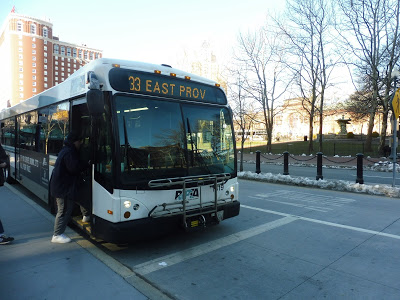 |
| A hastily-taken picture while boarding. |
We headed down Washington Street over the Providence River, and then it was straight into the tunnel! I always get a huge thrill going through that thing, even though the ride is only about 20 seconds long. We popped out at Thayer Street, where there were lots of student-oriented businesses and restaurants, but they thinned out as we made our way onto Waterman Street.
 |
| Thayer Street! |
The street was overwhelmingly residential, but some of the houses had offices or businesses within them. We eventually hit Wayland Square, though, conveniently located on Wayland Street – there was more retail here. This was a quick burst, and after some houses and a nice park, we were heading onto the Henderson Bridge over the Seekonk River, into East Providence.
 |
| Nice view! |
We took the first exit off the bridge, which led us onto Massasoit Ave. This industrial road curved eastward and started to gain dense houses and some businesses. Eventually, we arrived at East Providence’s bowtie-shaped downtown, and we used its weird network of one-way streets to get onto Taunton Ave. This had suburban businesses along it, as well as…oooh, a deviation! Yes, we headed into Wampanoag Plaza to serve its Stop & Shop.
 |
| Fun! |
We headed down Pawtucket Ave after that wonderful deviation, passing the East Providence High School and the local senior center. There were tons of industrial-type businesses along the road after we crossed Waterman Ave, but it changed soon after we crossed I-195. The street became lined with dense houses, and that continued until the retail came back around Martin Street.
 |
| A water tower! |
It was houses again for a stretch, but other attractions along there included Bradley Hospital and a Catholic school. We came up alongside a golf course for a bit, and then it got more industrial. The road became Bullocks Point Ave, and at this point, we were running by a little bit of everything. There were houses, apartments, businesses, industrial buildings, and the entrance to some sort of water filtration plant.
 |
| A little square of sorts. |
It settled on houses with the occasional business eventually, and we turned onto Crescent Point Ave near an apartment development. We went over Bullock Cove, which was a lot less scenic than it sounds, then we went through one more residential area. After a small circle with some suburban businesses, we arrived at Shaw’s, part of a terrible shopping plaza just next to the Barrington border.
 |
| Have fun on your 26-minute layover! |
RIPTA Route: 33 (Riverside)
Ridership: My Saturday morning ride seemed to get a good amount of people: there were 15 in total.
Pros: The 33 has a huge independent section, cutting straight down the length of East Providence. Also, it runs through the city, turning into the 17 to serve Olneyville Square, and passengers are free to stay on the bus – from what I saw, a good amount of people do that. The route runs every half hour on weekdays, every 45 minutes on Saturdays, and every hour nights and Sundays, which seems to make sense for the ridership.
Cons: The route seems to have some serious padding issues. For example, on the outbound trip, we had to wait for four minutes at Wampanoag Plaza because we were early. On the inbound, meanwhile, the driver left Shaw’s five minutes late, but we still ended up being early at the plaza! This route also has a ridiculous amount of layover time, especially considering the padding – on weekdays, for instance, it gets 27 minutes of layover…with 30 minute headways, remember! That means that a bus is arriving at Shaw’s just as a Providence-bound vehicle is leaving. And finally, RIPTA is really pushing the interlining here – would it solidify it better if the two routes were just combined? It would make no difference to how it’s run, but it would make a lot more sense to passengers!
Nearby and Noteworthy: The retail comes mostly in the form of lifeless suburban businesses and shopping centers, so I can’t say I have much to recommend here.
Final Verdict: 6/10
The most annoying thing about the 33 is its padding and layover time! I mean, they give the route enough time that they could shave off an entire bus but keep the same headways. I decided to reschedule the whole route, because I’m crazy:
You can also see it full-size here. My mindset here was getting rid of padding while still keeping the same frequencies. On weekdays, the trip time for most of the day is 67 minutes; I shortened it to 63 minutes, but there’s still a total of 21 minutes of layover, so buses should be able to stay on time. The best part is that my schedule only uses five of them, while the current schedule uses six. I managed to get an hourly schedule weeknights, but that required shortening the running time and giving the route only 2 minutes of layover. This is the biggest flaw in the schedule – headways could be increased to 70 minutes if reliability is an issue, although the buses would admittedly travel much faster at night.
On Saturdays, things are almost as tight, with a total of just 8 minutes of layover. I think it would work for the most part, and it makes the route able to run at the same frequency with 3 buses instead of 4, but if something goes wrong, it’ll have a domino effect. It might be worth reducing the Saturday frequencies to every 50 minutes, which isn’t a huge loss, especially considering the cost savings to RIPTA.
Indeed, that’s exactly what I did on Sundays, shortening the headways to every 50 minutes. It doesn’t cut any buses off the route, but why run it with three buses if they’re laying over for 56 minutes, which is the case in the current schedule? My schedule has 23 minutes of layover, but the route might even be able to run every 45 minutes if there’s demand. And that’s it! Just a few minor adjustments, and we get a route that runs just as frequently, if not more frequently, with fewer buses and mostly equal reliability! Sounds like a no-brainer to me!
Latest MBTA News: Service Updates
RIPTA: 35 (Rumford/Newport Ave)
Well, well, well, we finally return to my first RIPTA route! I was super excited to ride the 35 when I first did my Service Change post on it, but what is the 35 like as a route? Only one way to find out…
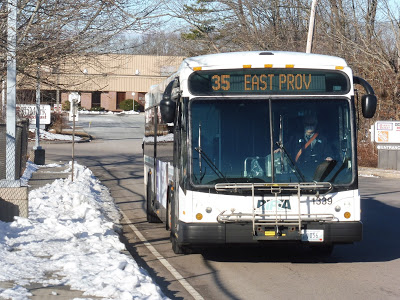 |
| We’re going all the way to Prov, not East Prov! |
We began in Massachusetts – South Attleboro Station – but a quick jaunt on Newport Ave over the Commuter Rail tracks led us into Pawtucket, RI. Now, in my original 35 post, I talked about how I liked this neighborhood for some reason. Uhh…it was just a bunch of trashy businesses, at least along Newport Ave. No, I do not like this neighborhood anymore.
 |
| Cigar Bar, anyone? |
Once the 1 left us to go onto Cottage Street and we were all alone, it started to get more residential. Newport Ave was now lined primarily with dense houses, but those businesses still showed up sometimes. Other points of interest included a church, a middle school, connections to the 76 and 80 on their respective streets, and Hasbro headquarters, which is in the most unlikely of places here in Pawtucket!
 |
| I was sitting on the wrong side for Hasbro, so have some houses instead. |
After some retaily at the intersection with Armistice Boulevard, we went through a residential neighborhood before passing Slater Park and going under some pylons. There were a few dead shopping plazas where we were joined by the 78, and this is also where we entered East Providence. It was for a relatively short time, though; after we passed tons of gross businesses, we turned onto Wilson Ave, leaving the 78 behind.
 |
| Well, this is different! |
The character of the route completely changed. We were now in a pleasant residential neighborhood! Eventually, we turned onto Roger Williams Ave, which ran right alongside a lake. Once the lake ended, we went under a railroad bridge and over the Ten Mile River, then we turned onto North Broadway. The businesses were back…
 |
| The lake, the lake! |
We went through a half-interchange with the uncompleted Henderson Expressway, and soon after that, we arrived at the bowtie-shaped road arrangement of what I guess is downtown East Providence. Making our way around onto Taunton Ave via the weird one-way streets, we were going by mostly more businesses. We also passed East Providence City Hall, which was…uh…unimpressive.
 |
| Uncompleted highways are interesting! |
When I previously rode the 35, it went through the East Providence Transit Tunnel, but since then, RIPTA moved it to take a more direct route. Thus, we suddenly got onto a ramp for I-195, which took us over the Seekonk River into Providence proper. We ran express through Fox Point before taking Exit 2, spitting us out onto South Main Street. There was undeveloped land for a bit, but then we travelled through one of my favorite parts of Providence, featuring historical buildings and quirky businesses. Finally, we headed over the Providence River on Exchange Terrace and came into Kennedy Plaza.
 |
| Time for a trip back out. |
RIPTA Route: 35 (Rumford/Newport Ave)
Ridership: I took the first inbound trip on a Saturday, and it got about ten riders. Honestly, that’s not bad, and I’m sure it gets busier later in the day.
Pros: This is the closest thing RIPTA has to an urban crosstown route, and I really appreciate it for that. It runs north-south through Pawtucket, which mostly has routes going east-west towards the downtown, so this crosstown bus is fantastic. On weekdays, its schedule is passable, with service every 45 minutes.
Cons: Woahhhhh, every hour and a half on weekends??? This is an urban route! Who the heck is gonna ride a route that runs that infrequently? Yeah, that’s honestly my only qualm with the 35, but every 90 minutes is just ridiculously infrequent, and it’s hard to get past.
Nearby and Noteworthy: Okay, I probably made it clear I didn’t especially like the neighborhoods the 35 served. Sorry. But hey, Hasbro!
Final Verdict: 6/10
Almost everything about the 35 is solid. It’s straight, it serves a lot, and it acts as a crosstown in a system with very few crosstown services. That weekend schedule, though…geez, it’s so darn infrequent! It’s painful to see a city bus route that only runs every hour and a half, and I’ll bet there’s enough ridership to support service every 45 minutes or even every hour.
Latest MBTA News: Service Updates
North Billerica (1000th post!)
Well, this was a surprise! NBC was still with me, and I was worried that North Billerica was going to be boring – apparently, that is absolutely not the case!
 |
| Looking down the ol’ platform. |
Okay, we’ll start with the platform, which is the least interesting part of the station. There’s a long low-level section with mostly signs and wastebaskets along it. There are mini-high platforms on the northern end of the station and benches underneath their shelters on both sides. The inbound side has some sheltered bike racks, which is a great place to put them.
 |
| SHOOT, THE PAPARAZZI GOT ME!!!! |
Ah, but here we have North Billerica’s crown jewel: the inbound side has a building! Now, even from the outside, it’s a nice structure. There are a few benches beneath its awnings for people to wait for trains, and it even has a payphone on the outside – too bad it’s broken.
 |
| WOAH. |
Now, most buildings on the Commuter Rail are only open for the morning rush period, BUT THIS ONE IS OPEN ALL THE TIME! AND IT HAS A TON OF BENCHES INSIDE! AND IT’S HEATED! AND IT HAS FREE WI-FI! AND THERE ARE VENDING MACHINES! AND IT HAS A WATER FOUNTAIN AND REALLY NICE, CLEAN BATHROOMS! SERIOUSLY, THIS IS SO CHARMING AND INCREDIBLE AND I LOVE IT TO AN INSANE DEGREE!!! I’M SURE NOTHING WILL COME UP TO SCREW THIS STATION UP!!!!!
 |
| Ohhhhhhhh…oh nooooooo… |
 |
| That’s a lotta commuters! |
A thousand posts???? Woah, okay, that’s a lot of posts! Uhhh…wow, this really snuck on me. Thanks for reading all the tomfoolery I’ve been writing a thousand times over!
